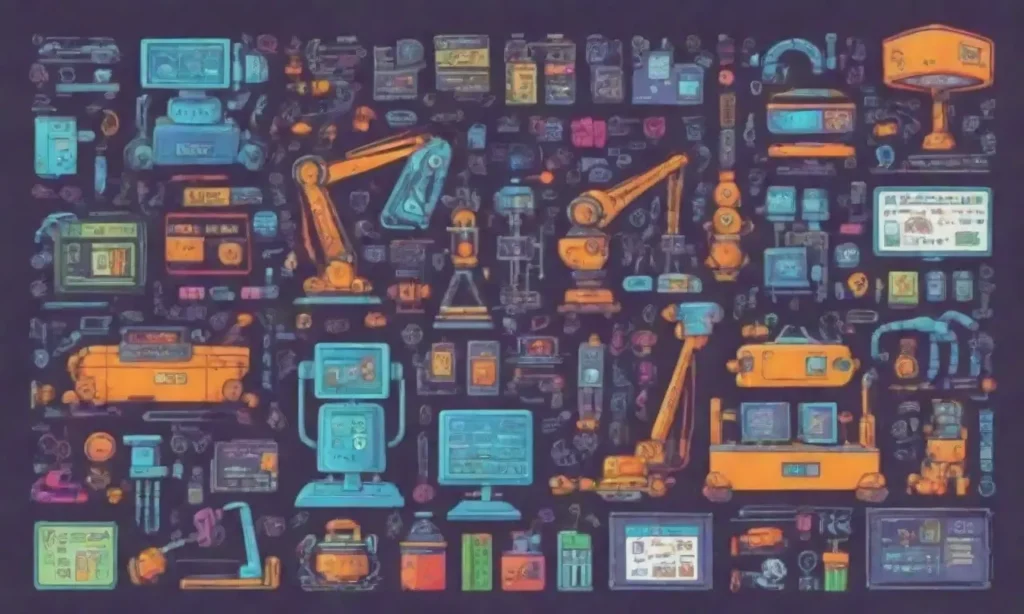
Improving Production Efficiency with AI-Powered Automation Tools

Introduction
In the ever-evolving landscape of industrial operations, the integration of AI-powered automation tools is becoming a pivotal factor in enhancing production efficiency. As manufacturers are continually faced with mounting pressures to optimize productivity, reduce costs, and improve product quality, the adoption of automation technologies enabled by artificial intelligence has emerged as a viable solution. Such tools not only streamline processes but also revolutionize traditional operational strategies, creating a more responsive and agile production environment.
This article delves into the myriad of ways in which AI-powered automation tools can significantly improve production efficiency. From real-time monitoring and data analysis to predictive maintenance and intelligent robotics, we will explore the transformative power of these technologies. Readers will gain insights into how businesses can leverage these advancements to stay competitive in a dynamic market landscape.
The Role of AI in Automation
Artificial Intelligence has fundamentally altered the concept of automation within the manufacturing sector. Traditionally, automation referred to the use of machinery and control systems to perform tasks without human intervention. However, with the advent of AI, this definition has expanded to encompass self-learning algorithms that can analyze vast amounts of data, identify patterns, and make informed decisions autonomously.
At its core, AI-powered automation enhances the ability of systems to not only execute repetitive tasks but also optimize processes based on real-time insights. For instance, AI algorithms can analyze production data to identify bottlenecks, then automatically reallocate resources or adjust workflows to enhance overall efficiency. As a result, processes become more dynamic, adaptive, and capable of maximizing output while minimizing waste.
Exploring the Potential of Generative Models in Industrial DesignFurthermore, AI creates opportunities for increased customization, allowing manufacturers to tailor production lines to specific client needs efficiently. This can lead to shorter lead times and higher customer satisfaction, as companies can react more swiftly to changing consumer demands. In summary, AI's role in automation not only boosts efficiency but also transforms operational paradigms to promote smarter, more responsive production environments.
Enhancing Production Line Efficiency
The integration of automation tools powered by AI plays a crucial role in refining the efficiency of production lines. One of the primary benefits of AI is its capability to perform real-time monitoring and analysis of production processes. Through the use of IoT devices and sensors, manufacturers can gather data regarding machine performance, production speed, and even environmental conditions.
For instance, smart sensors embedded within machines can relay information on operational status and performance metrics directly to centralized monitoring systems. AI tools can analyze this data to predict production rates, assess machinery health, and even suggest schedules for preventive maintenance. This proactive approach not only mitigates downtime caused by equipment failures but also ensures that production lines operate at optimal capabilities.
In addition to monitoring, AI-enhanced automation tools facilitate improved inventory management. By utilizing predictive analytics, companies can more accurately forecast inventory needs based on historical trends and market fluctuations. This allows manufacturers to maintain optimal stock levels, preventing both overstock situations that can tie up capital and stockouts that can halt production. The result is a streamlined supply chain that is responsive to real-time demands, ultimately improving production efficiency.
Intelligent Robotics
Manufacturing environments are increasingly incorporating robotic systems equipped with AI capabilities, further enhancing production efficiency. These intelligent robots can undertake diverse tasks ranging from assembly to quality control with a precision that far exceeds human capabilities. The flexibility of AI-powered robotics allows for the adaptation of these systems to various manufacturing processes, promoting versatility within production lines.
AI robotics are particularly notable for their ability to learn from previous tasks and adapt their techniques accordingly. For example, a robot designed for quality inspection can utilize machine learning algorithms to recognize defects in products with increasing accuracy over time. By minimizing error rates, the quality of finished products improves, which not only reduces waste but also bolsters brand reputation.
In addition, collaboration between humans and robots—often termed cobots—is steadily gaining traction in modern manufacturing facilities. These cobots can assist human workers on the factory floor by taking over repetitive or physically demanding tasks, thereby allowing employees to focus on more strategic and inventive projects. This collaboration leads to enhanced workforce productivity and ensures that human resources are utilized most effectively.
Predictive Maintenance
One of the most transformative applications of AI in manufacturing is predictive maintenance. Traditional maintenance strategies are often reactive; repairs occur only after a machine fails. This approach can be costly, leading to unplanned downtime that disrupts production schedules and results in significant financial losses. Predictive maintenance, powered by AI technologies, shifts the paradigm by allowing manufacturers to anticipate failures before they happen.
By leveraging advanced data analytics, AI tools continuously monitor machinery and predict when maintenance is required based on machine health indicators and operational usage. Using historical data, these systems can learn patterns that precede equipment failures, enabling a more proactive approach to maintenance. By implementing predictive maintenance, manufacturers can schedule maintenance during non-peak hours, thus minimizing disruptions and maintaining continuity in production.
Ultimately, the integration of predictive maintenance enhances overall operational efficiency by ensuring that machines are always operating at peak performance. It also extends the lifespan of equipment through proper care, further driving down costs associated with wear and tear. By investing in AI predictive maintenance technologies, manufacturers can achieve significant gains in efficiency, reliability, and overall productivity.
Customization and Market Responsiveness

As consumer preferences evolve and markets become increasingly competitive, the ability to customize products swiftly and accurately has become paramount for manufacturers. AI-powered automation tools significantly enhance manufacturing agility, allowing companies to respond promptly to changing consumer demands without sacrificing production efficiency.
With advanced data analytics capabilities, manufacturers can closely monitor market trends and consumer behavior patterns. AI tools can process vast amounts of data from various sources, including social media, e-commerce platforms, and market research reports. By analyzing this data, companies can identify shifts in consumer preferences and rapidly adjust production strategies to remain aligned with market demand.
Moreover, AI technologies enable mass customization, where products can be tailored to meet individual customer preferences without disrupting the overall production flow. This is achieved through the implementation of flexible manufacturing systems that can easily reconfigure production processes at scale. As a result, businesses can offer personalized products while maintaining cost efficiency, providing a competitive edge in an increasingly dynamic market landscape.
Additionally, AI's capacity for real-time adjustments to production processes ensures that manufacturers can pivot quickly in response to unforeseen circumstances, like supply chain disruptions or shifts in demand due to seasonality. This remarkable flexibility ultimately leads to increased customer satisfaction and loyalty, as organizations can provide timely and relevant products tailored to their audience's needs.
Conclusion
The incorporation of AI-powered automation tools in production processes is more than just a technological advancement; it represents a significant paradigm shift in the way manufacturers operate. By enhancing production line efficiency, enabling intelligent robotics, and implementing predictive maintenance, businesses can significantly reduce costs while increasing output and product quality.
Moreover, the capability to customize offerings and rapidly adapt to market changes allows manufacturers to position themselves effectively against competitors. Ultimately, embracing AI technologies equips manufacturers with the tools necessary for sustained success in an increasingly competitive landscape.
As industries continue to evolve, the importance of integrating AI-powered automation tools will grow. Organizations that prioritize these advancements will not only see immediate benefits in production efficiency but will also lay the groundwork for future innovations and expansions. By harnessing the transformative power of AI, manufacturers can truly reshape their operational strategies and achieve a new level of productivity and responsiveness in an interconnected world.
If you want to read more articles similar to Improving Production Efficiency with AI-Powered Automation Tools, you can visit the Industrial Automation category.



You Must Read